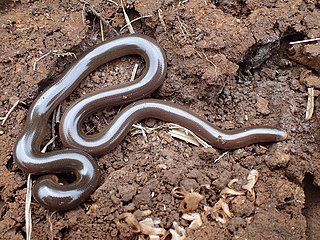
Psammophis is a genus of snakes in the family Psammophiidae. The genus comprises 33 species, which are found in Africa and Asia. Psammophis are diurnal and prey on lizards and rodents which they actively hunt. All species in the genus are venomous, and the venom is considered mild and not dangerous to humans.

Trachylepis is a skink genus in the subfamily Mabuyinae found mainly in Africa. Its members were formerly included in the "wastebin taxon" Mabuya, and for some time in Euprepis. As defined today, Trachylepis contains the clade of Afro-Malagasy mabuyas. The genus also contains a species from the Brazilian island of Fernando de Noronha, T. atlantica, and may occur in mainland South America with Trachylepis tschudii and Trachylepis maculata, both poorly known and enigmatic. The ancestors of T. atlantica are believed to have rafted across the Atlantic from Africa during the last 9 million years.
Letheobia is a genus of blind snakes in the family Typhlopidae.

Epictia is a genus of snakes in the family Leptotyphlopidae. The genus is native to South America, Central America, and Mexico.

Lycophidion is a genus of nonvenomous lamprophiid snakes commonly referred to as the wolf snakes.
The Angola blind snake or Angolan blind snake is a species of snake in the Typhlopidae family. While named after its type locality in Angola, it is widespread in Central and East Africa. Specifically, it is found in Angola, northern Zambia, the Democratic Republic of the Congo, the Republic of the Congo, Gabon, Cameroon, the Central African Republic, Tanzania, Uganda, Kenya, Rwanda, and Burundi.
The Angolan giant blind snake or Angolan giant blind-snake, also known as the anomalous beaked snake, is a species of snake in the Typhlopidae family. It is endemic to Angola. Its classification was changed from Rhinotyphlops to Megatyphlops when Rhinotyphlops was found to be polyphyletic. In 2014 Megatyphlops was changed to Afrotyphlops.

Bibron's blind snake is a species of snake in the family Typhlopidae. The species is native to southern Africa.
Gierra's blind snake, also commonly called the Usambara spotted blind snake and the Usambara spotted worm snake, is a species of snake in the family Typhlopidae. The species is endemic to Tanzania.
Schmidt's blind snake is a species of snake in the family Typhlopidae. The species is endemic to Central and Southern Africa.
Steinhaus's worm snake is a species of snake in the family Typhlopidae. The species is endemic to Central Africa.

Afrotyphlops schlegelii, commonly known as Schlegel's beaked blind snake or Schlegel's giant blind snake, is a species of snake in the family Typhlopidae. The species is endemic to eastern and southern Africa, and bears the distinction of being the world's largest typhlopid. It is harmless to humans and lives exclusively on a diet of termites.

Prosymna is a genus of elapoid snake. It is the only genus in the family Prosymnidae. They were formerly placed as a subfamily of the Lamprophiidae, but have been more recently identified as a distinct family.

Philothamnus is a genus of snakes in the family Colubridae. The genus is endemic to Sub-Saharan Africa.

Indotyphlops is a genus of snakes of the family Typhlopidae. The genus is endemic to Asia.

Myriopholis is a genus of snakes in the family Leptotyphlopidae. Most of the species were previously placed in the genus Leptotyphlops.
Afrotyphlops blanfordii, or Blanford's blind-snake, is a species of snake in the family Typhlopidae. The species is native to the Horn of Africa.










